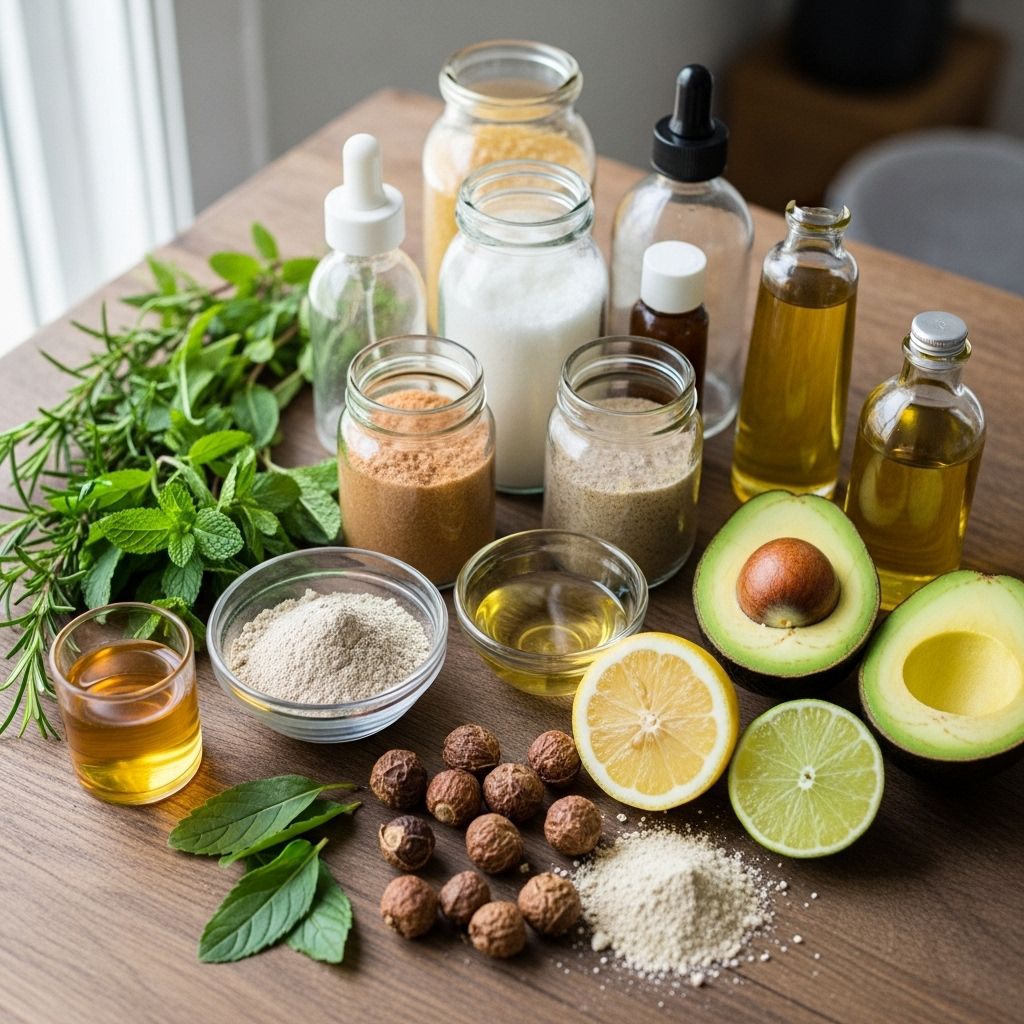Homemade Shampoo Recipes Without Castile Soap: Natural Alternatives for Clean, Healthy Hair
Discover nourishing, easy-to-make shampoos using everyday ingredients—no Castile soap required.

Homemade Shampoo Recipes Without Castile Soap
Many natural haircare enthusiasts seek to avoid harsh chemicals by creating their own homemade shampoo. While Castile soap is a common foundation in many DIY recipes, it isn’t ideal for all hair types—some find it too drying, and others prefer an even milder, soap-free approach. Fortunately, there are plenty of effective ways to cleanse and nourish your hair without Castile soap, using ingredients you likely already have at home.
Why Choose Homemade Shampoo Without Castile Soap?
Castile soap is a plant-based, gentle cleanser, but it still has alkaline properties that can disrupt the natural pH of hair and scalp for some people. Others find it leaves their hair dry, frizzy, or with a waxy buildup—especially in areas with hard water. By using alternative natural cleansers, you can better tailor your haircare routine to your hair’s unique needs, maximizing moisture and shine while minimizing irritation and ingredient sensitivity.
- Mix up nourishing shampoos with common pantry items: eggs, oils, herbs, clays, or natural exfoliants.
- Maintain your hair’s natural pH and avoid heaviness or residue.
- Eliminate synthetic fragrances and preservatives from your routine.
- Create custom blends for normal, oily, or damaged hair—they’re suitable for almost everyone!
Common Issues with Castile Soap in Shampoo
- Dryness: Some hair feels stripped or brittle after use.
- Residue: Can leave a dull film with hard water.
- Imbalanced pH: Alkalinity may upset scalp health and increase frizz.
- Limited compatibility: Curly, color-treated, and fine hair may not respond well.
Essential Ingredients for Castile-Free DIY Shampoo
Homemade shampoos without Castile soap draw from nourishing natural ingredients, each with specific hair benefits. These can be tailored for cleansing, hydration, or scalp care:
- Eggs – Provide protein and natural cleansing for strength and shine.
- Olive oil or coconut oil – Moisturize, tame frizz, and replenish lipid balance.
- Lemon juice or apple cider vinegar – Help to clarify, balance pH, and add shine.
- Aloe vera gel – Soothes the scalp and hydrates hair.
- Herbal teas (like green tea) – Offer antioxidants and stimulate the scalp.
- Honey – Acts as a gentle humectant, drawing moisture into hair.
- Essential oils – Provide scent and additional hair or scalp support.
Homemade Shampoo Recipes Without Castile Soap
Below are several tried-and-true shampoo recipes, featuring simple directions and a minimal ingredient list. Customize these recipes using your preferred oils or herbs to best suit your hair’s texture and needs.
Egg & Olive Oil Shampoo
This gentle recipe delivers natural protein and moisture, promoting stronger, shinier hair. It’s a classic choice for those seeking rich nourishment without heaviness or chemicals.
- Ingredients:
- 1 egg (both yolk and white)
- 2 tablespoons olive oil
- 1 tablespoon lemon juice
- 1 teaspoon apple cider vinegar
Instructions:
- Add all ingredients into a small bowl.
- Blend or whisk until thoroughly combined and slightly frothy.
- Pour the mixture into a cup or applicator bottle.
- Wet hair with warm water, then gently massage the shampoo into scalp and hair, focusing on roots.
- Rinse thoroughly with lukewarm (not hot) water.
- Discard leftovers after one use, as this mixture is perishable and should not be stored.
Aloe Vera & Coconut Milk Shampoo
This hydrating shampoo is perfect for dry or damaged hair. Aloe vera soothes the scalp, while coconut milk nourishes and cleanses.
- Ingredients:
- 1 1/2 cups water
- 70 grams coconut flakes
- 1 3/4 cups aloe vera gel (fresh or store-bought, with minimal preservatives)
- 5 drops lavender essential oil (optional, for fragrance and scalp support)
Instructions:
- Blend the coconut flakes with water until smooth, then strain to create coconut milk.
- Mix with aloe vera gel and essential oil.
- Pour into a bottle and shake to combine.
- Massage into wet scalp and hair, then rinse thoroughly.
- Store unused shampoo in the refrigerator for up to 1 week.
Coconut Milk & Honey Shampoo
This gentle recipe suits all hair types, offering a mild cleanse and moisture without residues.
- Ingredients:
- 1 can (13.5 oz) full-fat coconut milk
- 2 tablespoons raw honey
- 1 teaspoon jojoba oil
- 1 teaspoon castor oil
- 2 tablespoons apple cider vinegar (optional—clarifies and adds shine)
Instructions:
- Combine all ingredients in a bottle or bowl.
- Stir or shake until fully blended.
- Apply to scalp and hair, massaging gently. Leave on for 2–5 minutes.
- Rinse thoroughly. Repeat if needed.
Nourishing Homemade Conditioner Recipes (No Castile Soap)
Pair your shampoo with one of these ultra-moisturizing conditioners, designed to boost softness and shine while detangling hair naturally.
Egg Yolk & Olive Oil Conditioner
- Ingredients:
- 1 egg yolk
- 1/2 teaspoon olive oil
- 3/4 cup lukewarm water
Instructions:
- Separate egg yolk from white.
- Beat the yolk and olive oil together until well blended.
- Add water gradually while mixing.
- Apply generously to clean, damp hair after shampooing. Leave on for 10 minutes.
- Rinse thoroughly with cool to lukewarm water.
Coconut Oil & Green Tea Conditioner
- Ingredients:
- 1 tablespoon virgin coconut oil
- 1 tablespoon castor oil
- 1 cup brewed green tea (cooled)
- 3 drops lavender essential oil
Instructions:
- Combine all oils and green tea in a small bottle or jar.
- Add essential oil and shake vigorously.
- Apply 1–2 tablespoons to wet hair, focusing on lengths and ends.
- Comb through, let sit 5–10 minutes, then rinse well.
Tips for Successfully Using DIY Shampoos Without Castile Soap
- Spot Test: Patch test new mixtures on skin or a small hair section first, especially if using eggs or essential oils.
- Storage: Most recipes with fresh or perishable ingredients should be made in small batches and refrigerated. Use within 1 week.
- Transition Period: Your hair may take time to adjust, especially if you’re switching from commercial shampoos containing silicones and sulfates.
- Rinse Well: Thorough rinsing prevents residue or stickiness, especially with egg or oil-based formulas.
- Customize: Adjust oil or honey amounts depending on your hair’s oiliness or dryness.
FAQs: Homemade Shampoo Without Castile Soap
Q: Why avoid Castile soap in homemade shampoos?
A: Although Castile soap is natural, its alkaline pH can disrupt scalp balance, and it may leave residue or cause dryness, particularly in hard-water areas or for certain hair types.
Q: Can I store leftover homemade shampoo or conditioner?
A: Most recipes containing eggs, fresh plants, or dairy should be used within a few days and kept in the fridge. Some can spoil quickly; always discard if color, smell, or texture changes.
Q: What hair type are these shampoos suitable for?
A: These Castile-free shampoos work for normal, oily, and dry hair, but formulas with extra oils are particularly good for dry, damaged, or curly hair. Adjust ingredients as needed.
Q: Are there vegan alternatives?
A: Yes! Omit egg and swap honey for agave or maple syrup. Focus on plant-based options like coconut milk, aloe vera, and herbal infusions. Clays and oat water are also effective cleansers.
Q: How often should I wash hair with homemade recipes?
A: Use as often as you would your regular shampoo—generally 2–3 times per week. Those with drier hair may prefer once weekly.
Table: DIY Shampoo Recipe Comparison
| Recipe | Main Ingredients | Suitable Hair Type | Key Benefit |
|---|---|---|---|
| Egg & Olive Oil Shampoo | Egg, olive oil, lemon juice, apple cider vinegar | Normal to dry | Deeply nourishing, adds shine |
| Aloe Vera & Coconut Shampoo | Coconut flakes, aloe vera, water | Damaged or dry | Hydrates and repairs |
| Coconut Milk & Honey Shampoo | Coconut milk, honey, oils | All hair types | Mild cleanse and moisture |
Final Thoughts & Further Customization Ideas
Switching to homemade shampoo without Castile soap can transform your hair health by simplifying your routine and customizing every ingredient. Depending on your specific needs, you can incorporate simple herbal rinses (like chamomile or rosemary tea), finely ground oats for soothing properties, or clays (like bentonite) for gentle scalp detox.
- For extra shine: Rinse with diluted apple cider vinegar after shampooing.
- For volume: Add a pinch of baking soda to the shampoo blend (occasionally, not daily).
- For stronger hair: Replace water with horsetail or nettle tea.
- Avoid overuse of oils if you have very fine or oily hair; use light blends or increase the proportion of lemon juice or tea.
With these natural, Castile-free shampoo recipes, you can enjoy clean, soft hair and a healthy scalp—without compromise.
References
- https://rusticwise.com/homemade-shampoo-without-castile-soap/
- https://www.vedaoils.com/blogs/soapmaking/homemade-shampoo-without-castile-soap
- https://www.healthline.com/health/beauty-skin-care/homemade-shampoo
- https://www.youtube.com/watch?v=jzaVEYYHDC0
- https://www.schoolofnaturalskincare.com/whats-wrong-with-diy-shampoo-recipes/
- https://www.chocobo.yoga/healthy-chocobo/essential-oils-recipes/diy-shampoo-with-essential-oils-without-castile-soap/
- https://www.soapmakingforum.com/threads/liquid-shampoo-without-castile-soap.59567/
Read full bio of medha deb












